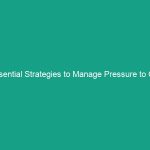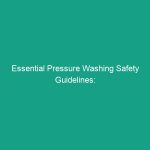Introduction
Good morning team! Today, we are going to talk about an important subject that affects not just the quality of our work, but also our Safety: essential pressure washing guidelines. This Toolbox Talk will help us understand how to properly handle pressure washing tasks while avoiding common mistakes that can lead to accidents or injuries. Pressure washing is a powerful tool, and with great power comes great responsibility!
Understanding Essential Pressure Washing Guidelines
So, what do we mean by essential pressure washing guidelines? These are the protocols and practices that ensure safe and effective pressure washing in our workplace. Proper pressure washing not only enhances the appearance of our facilities but also helps maintain surfaces by preventing deterioration.
Many employees may think that pressure washing is straightforward, but it can actually be quite dangerous if not done correctly. Misunderstandings about pressure settings, nozzle selection, and Safety Gear can lead to serious injuries. Let’s dive deeper into the specific Hazards and risks associated with pressure washing.
Key Hazards, Risks, and Safety Considerations
Pressure washing can expose employees to a variety of hazards, including:
- High-Pressure Water Streams: These can cause severe injuries if they hit the skin or eyes.
- Slips and Falls: Wet surfaces can be slippery, increasing the risk of falls.
- Electrical Hazards: Using electric pressure washers near water can pose serious risks.
- Inhalation of Chemicals: Some pressure washing detergents can be harmful when inhaled.
Ignoring these hazards can lead to real-world consequences, such as serious injuries, property damage, and even legal issues. It’s imperative to recognize these risks and take appropriate measures to mitigate them.
Best Practices, Procedures, & Actionable Advice
Now that we understand the risks, let’s look at some Best Practices for safe pressure washing:
Step-by-Step Safety Procedures
- Wear Appropriate Personal Protective Equipment (PPE): Always wear Safety Goggles, gloves, and non-slip footwear.
- Inspect Equipment: Check your pressure washer for any damages or leaks before use. Make sure all safety features are functional.
- Choose the Right Nozzle: Different tasks require different nozzles. A narrow nozzle can cause damage, while a wide nozzle may not be effective.
- Maintain Safe Distances: Keep a safe distance from surfaces to prevent injury from the high-pressure stream.
- Be Aware of Your Surroundings: Check for obstacles, power lines, or people in the area before starting.
- Use Environmentally Friendly Detergents: Opt for biodegradable cleaning agents to minimize environmental impact.
Practical Tips and Real-Life Examples
Let’s consider a case study. Last year, one of our team members was using a pressure washer without properly checking the equipment. The nozzle was damaged, causing a high-pressure stream to spray back and injure their hand. By following the procedures outlined above, we can prevent such incidents from happening again.
Regulations, Standards, and Compliance
It’s essential to follow relevant Regulations and Standards, such as those set by OSHA. Compliance not only protects employees but also ensures we maintain a safe working Environment. For instance, osha mandates that all workers must be trained on how to use pressure washing equipment safely. Remember, being compliant is not just about following the law; it’s about looking out for one another.
Employee Engagement & Discussion
Now that we’ve covered the main points, let’s open the floor for discussion. What safety challenges have you encountered related to pressure washing? Have any of you had experiences or suggestions that could help us improve our practices? Your input is valuable, and together we can make our workplace safer.
Conclusion & Key Takeaways
To wrap up, here are the key takeaways from today’s Toolbox Talk:
- Always wear appropriate PPE.
- Inspect your equipment before use.
- Choose the right nozzle and maintain safe distances.
- Be aware of your surroundings and use eco-friendly detergents.
- Follow regulations and stay compliant with safety standards.
Thank you all for your attention and commitment to safety. Remember, by applying these essential pressure washing guidelines, we can ensure not only our safety but also the quality of our work. Let’s prioritize safety in everything we do!


